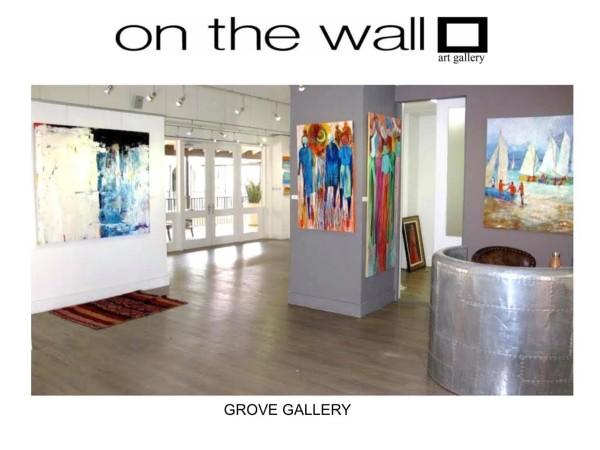
11 minute read
RITES, RITUALS, MEMORIES AND MORE CROP OVER VISUALARTS EXHIBITION OPENS
THURSDAY.
Barbados Today News.
“The first event produced by the National Cultural Foundation (NCF) for Crop Over 2023 starts next week and runs throughout the Season of Emancipation.
On Africa Day, Thursday, May 25, 2023, the NCF will host the official opening of the Central Bank of Barbados Crop Over Visual Arts Exhibition entitled We Came on Merchant Ships.
The following day, Friday, May 26, the three-part exhibition will then be open for public viewing at the Queen’s Park Gallery until Thursday, June 22.
The series of exhibitions seek to visually explore the concept of the necessity of trade for growth and expansion and all the consequences, rewards and challenges that come from migration, free, forced or otherwise.
The first exhibition, We Came on Merchant Ships – Movement, examines movement in its many forms. The works of 29 artists will be on show. The exhibition captures the reason people move, modalities for movement and the various cultural manifestations of migration - forced and free. Special emphasis will be placed on the transatlantic slave trade.
NCF’s Curator Oneka Small admits that although the topic is a tough one to approach, the Foundation was excited to showcase such a serious yet sensitive project using art. “Curating this one has not been an easy task simply because it is a painful period in our history, especially the show, which focuses a lot on the transatlantic slave trade. So we are very excited though to be presenting the information through multimedia presentations such as photography,” she said.
She added: “We have digital work. We also have sculptures. Some amazing pieces by amazing artists. We want to keep them under wraps so that you come excited on Friday, May 26, to see the show. It is a mixed medium, multimedia, all genre show. We are very happy to be presenting such a show this year.”
Small is curating the exhibition alongside colleague NCF’s Visual Arts Officer Rodney Ifill, who commended the artists for stepping up and exploring the topic. “We have 29 wonderful artists. We have so many artists on the island and I am glad that they responded to the theme because the whole idea of introducing themes like this is to get people to think, to research and then you become better for it. At the end of the day, you are now collecting a pool of knowledge that you would have gone away with in terms of your own personal interrogation and presenting your sensibility to the public,” he noted.
The second exhibition, We Came on Merchant Ships – Memories and Identity, which runs from Friday, June 30, to Thursday, July 27, the artists seek to interrogate the intangible aspects of trade. How do memories express themselves in displaced people? How is identity maintained, retained, or assimilated within the new land of settlement? The third exhibition, We Came of Merchant Ships –Rites, Ritual and Religion running from Friday, August 4 to Thursday, August 31 will see artists visually explore the continuation of rites, rituals and religion from the lands from which the present people of Barbados originated, for example, the Spiritual Baptist, Christianity and the rise of traditional African religions such as the practice of Yoruba, Hindu and other faiths.
For more information on details relating to the Exhibition, please contact Oneka Small via email at oneka-small@ncf.bb and Rodney Ifill Visual Arts Officer via email at rodney-ifill@ncf. bb (PR)”

Exhibition Explores Trade.
Saturday Sun News
Thursday's official opening of the Crop Over Visual Arts Exhibition titled We Came On Merchant Ships, marked the first event produced by the National Cultural Foundation (NCF) for Crop Over 2023.
Held at the Queen's Park Gallery, the exhibition, supported by the Central Bank of Barbados, was part of a series of three. It aims to visually explore the concept of trade's necessity for growth and expansion and the consequences, rewards and challenges that arise from migration, whether voluntary or forced.
Attendees were immersed in a distinctive and beautifully curated display featuring a diverse range of art forms, including paintings, sculptures, photography, installations, digital works, drawings and mixed media.
The evening commenced with an invocation by visual artist Ra Daniel Alleyne, followed by an invitation from NCF curator Oneka Small who expressed her excitement about featuring the works of 29 artists in this series.
The exhibition tour, led by Small, revealed the captivating stories behind each masterpiece, as participating artists shared their inspirations and techniques. Emerging and established artists, art enthusiasts and curators were among those taking in the thoughtprovoking art on display.
Singer Kweku Jelani and a talented guitarist provided performances throughout the evening. Guests enjoyed an open bar and had the opportunity to engage with artists present who described their works. Fashion stylist and abstract artist Katrina Mereigh praised the uniqueness and distinctiveness of the exhibit, recognising the challenge of weaving together such diverse pieces and styles into a cohesive exhibition.
It continues until August 31st
HER BLOOD SPOKE: JOSCELYN GARDNER, KARA SPRINGER, ALBERTA WHITTLE at Art Gallery Ontario, Toronto, Canada
April 15 - October 29, 2023
Alberta Whittle. Her blood spoke in Creole, in Gaelic, in Twi and in Yoruba, 2022. Acrylic, Florida Water, Bay Rum on cotton, Overall: 200 x 200 cm. Art Gallery of Ontario. Purchase, with funds from the Friends of Global Africa & the Diaspora, 2022. © Alberta Whittle. Courtesy of the artist and Nicola Vassell Gallery. Photo: Adam Reich Photography. 2022/7089.

Joscelyn Gardner, Kara Springer and Alberta Whittle at The Gallery of Ontario, Canada.
April 15 - October 29, 2023
‘Her Blood Spoke’: Joscelyn Gardner, Kara Springer, Alberta Whittle presents 16 artworks by three artists of Barbadian descent, reflecting on contemporary and historical experiences with Black maternal health and bodily autonomy. As access to reproductive healthcare remains precarious globally, this installation offers a consideration of the ways in which Black women's bodies have long been sites of conflict.
Featuring lithographs, photographs, painting and video, the artworks on view, use archival sleuthing, autobiography and conceptual storytelling to situate women's labour in conversation with themes of bodily agency, resistance, and ancestral care. Her Blood Spoke emerges from an awareness of the historical systems of racial and gendered violence that continue to shape our contemporary moment.
April 15 - October 29, 2023 https://ago.ca/exhibitions/her-blood-spoke-joscelyn-gardner-kara-springer-alberta-whittle
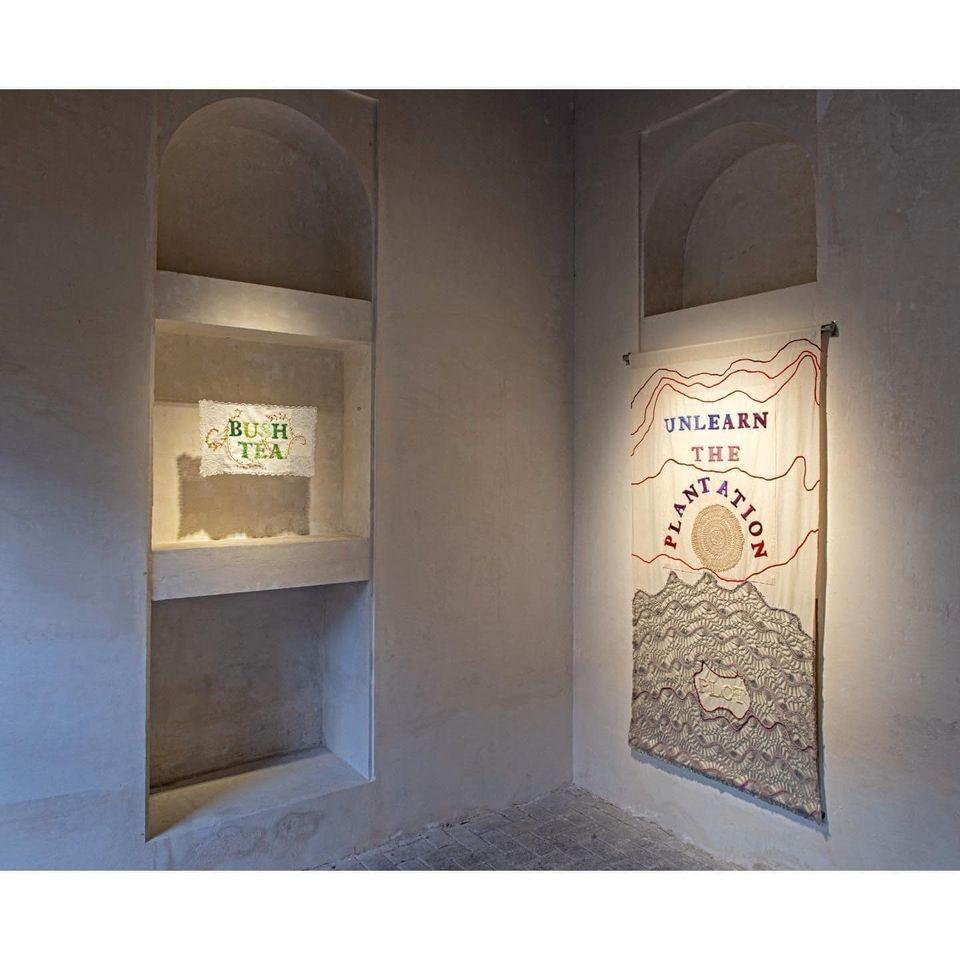
Annalee Davis on her Pray to Flowers – A Plot of Disalienation, my site-specific installation produced by the Sharjah Art Foundation for the SB15.
“Pray to Flowers – A Plot of Disalienation, my site-specific installation produced by the Sharjah Art Foundation for the SB15 runs till June 11. This post focuses on the attached interior space mirroring the densely layered garden.
These embroidered panels acknowledge British sewing traditions Barbadian women inherited over centuries. Practiced across races & classes, their habitual utilization of the needle & thread instilled notions of what it meant to be feminine. Pre-approved imagery, stitches, & colours replicated across samplers trained middle- and upper-class women into becoming submissive housewives abiding by the church’s teachings & moral codes of respectability.
Conversely, Pray to Flowers disregards the restricted range of carefully taught stitches, colour combinations, & sanctioned subject matter. Rather, these works interweave crochet, applique, & embroidery addressing more indelicate discourse such as the impact of mono-crop farming & the plantation on today’s climate crisis. Amalgamating time-honoured stitches with fabricated ones, 100year-old cutwork embroidery intermingles with contemporary so-called ‘African’ print fabrics worn at Barbados’ Crop Over festival. Merging pale pink crochet pieces & machine-made lace, this mash-up of fabrics, threads, & traditions acknowledges the creolization inherent in the formation of postindependent Barbados.
Instead of producing decorative works for the living room or dressing tables, – prescribed domains of women – these tapestries link the plantation with the 6th extinction. Cyanotypes of local botanicals growing in my garden acknowledge native flora rather than bluebells and cockleshells found in the embroidered tablecloths of my mother’s generation, fashioned on prescribed patterns they were fabricated. Satin-stitched phrases” advocate the worship of flowers, and our need to unlearn the plantation & defend nature.”
-Annalee Davis








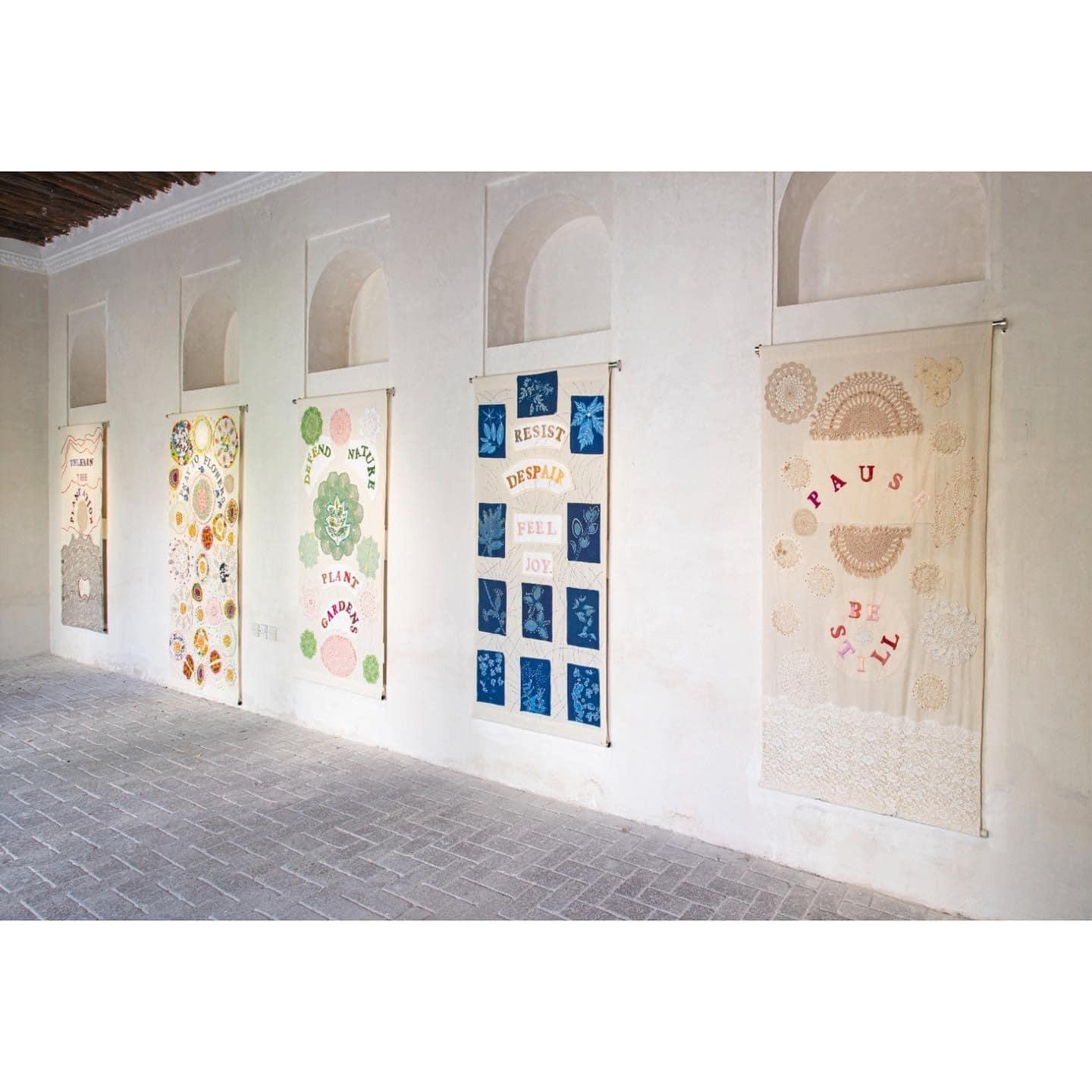


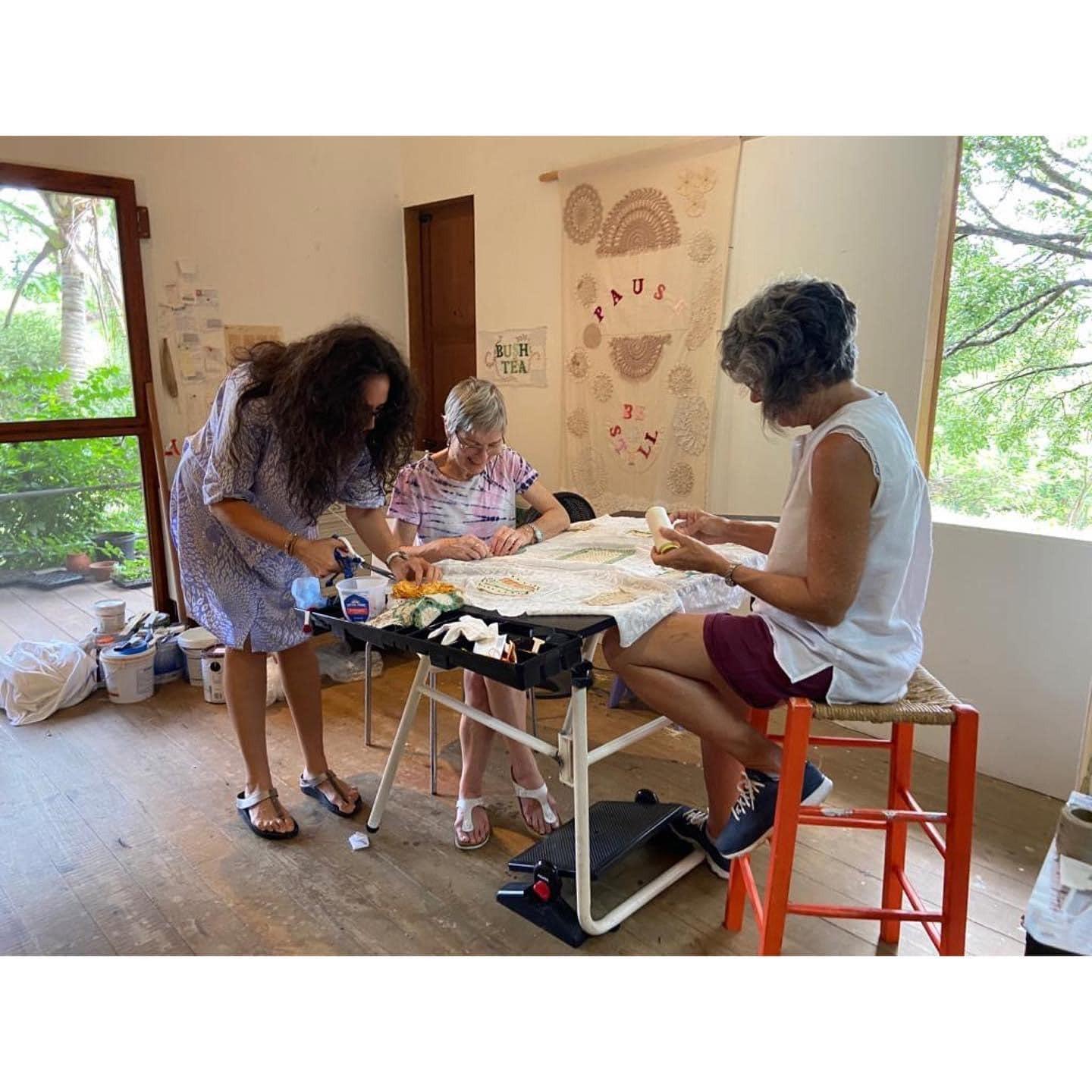



COLOURS OF BARBADOS Art Show on the Boardwalk
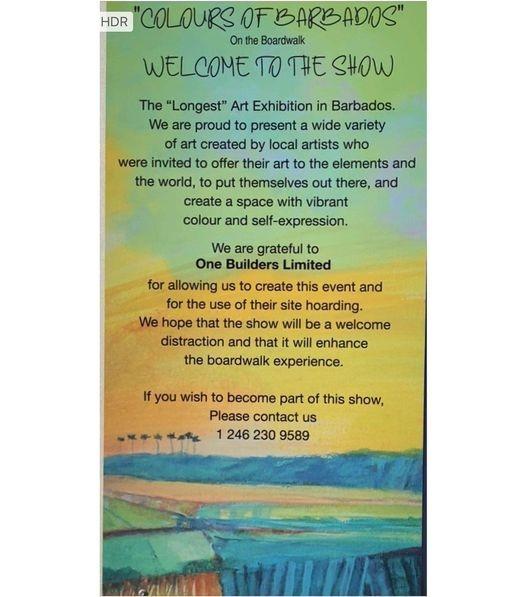
Just a few of the images here from opening day. The longest show. 350 feet long (and growing as artists add more pieces). The exhibition will run for 18 months. Opened on November 29th, 2022 Organised and hosted by James Edgehill and Mark Hiorns For more information Tel: 1 (246) 228 0631
Artists participating so far
Adrian Burnett
Andrea Dennison
Anna Didier
Arianna Holligan
Catherine Cummins
Cher Antoinette Corbin
Cindy Walker tbc
Frank Cossey tbc
Heidi Berger
Hilary Arnstrong
Jeena Chatrani
Julia Seymour
Karen Pearson
Kirstie Hiorns
Korea Darnelle
Kristine Dear
Maria Stanford
Mark Hiorns
Micah Rubin
Michelle Bowe
Princess Johnson
Priscilla Richardson
Providence
Reginald Gill
Sian Pampellonne
Yazmin Vizcarrondo


‘STUDIO ART BACHELOR OF FINE ARTS (BFA) PORTFOLIO 2023’

OPITIN’ at
Morningside Gallery, Barbados Community College
May 12th - May 19th
Congratulations to Evan McDonald for winning the Leslie Barrow prize at the STUDIO ART BACHELOR OF FINE ARTS (BFA) PORTFOLIO 2023’ exhibition ‘OPITIN’ at Barbados Community College. May 2023



Evan McDonald
My work investigates the social hierarchies, behaviours and historic narratives of Barbados. The site of investigation is an imagined 1940's village, based on readings and verbal accounts that span from that era, as well as before and after.
The artwork plays with tropes, traditional and nostalgic objects and language which are used to create immediate references. These include embroidered pieces, recognisable furnishings, iconic visuals, era inspired clothing and architectural references.
The investigation explores how white supremacist ideas of colour, class and gender hierarchies, manifest in the domestic and communal spaces of this village. Furthermore, how these harmful ideas are masked, hidden or embroidered to minimise the violence that occurred and results. The pieces highlight lived experiences, labels and talk of specific characters and households.
Archival artworks and writings have been essential to these creations. References at the core of these creations include artist Isaac Mendes Bellisario; writers George Lamming, Jeanette Layne-Clarke and Austin Clarke, as well as studies by Toni Morrison and Alice Walker.
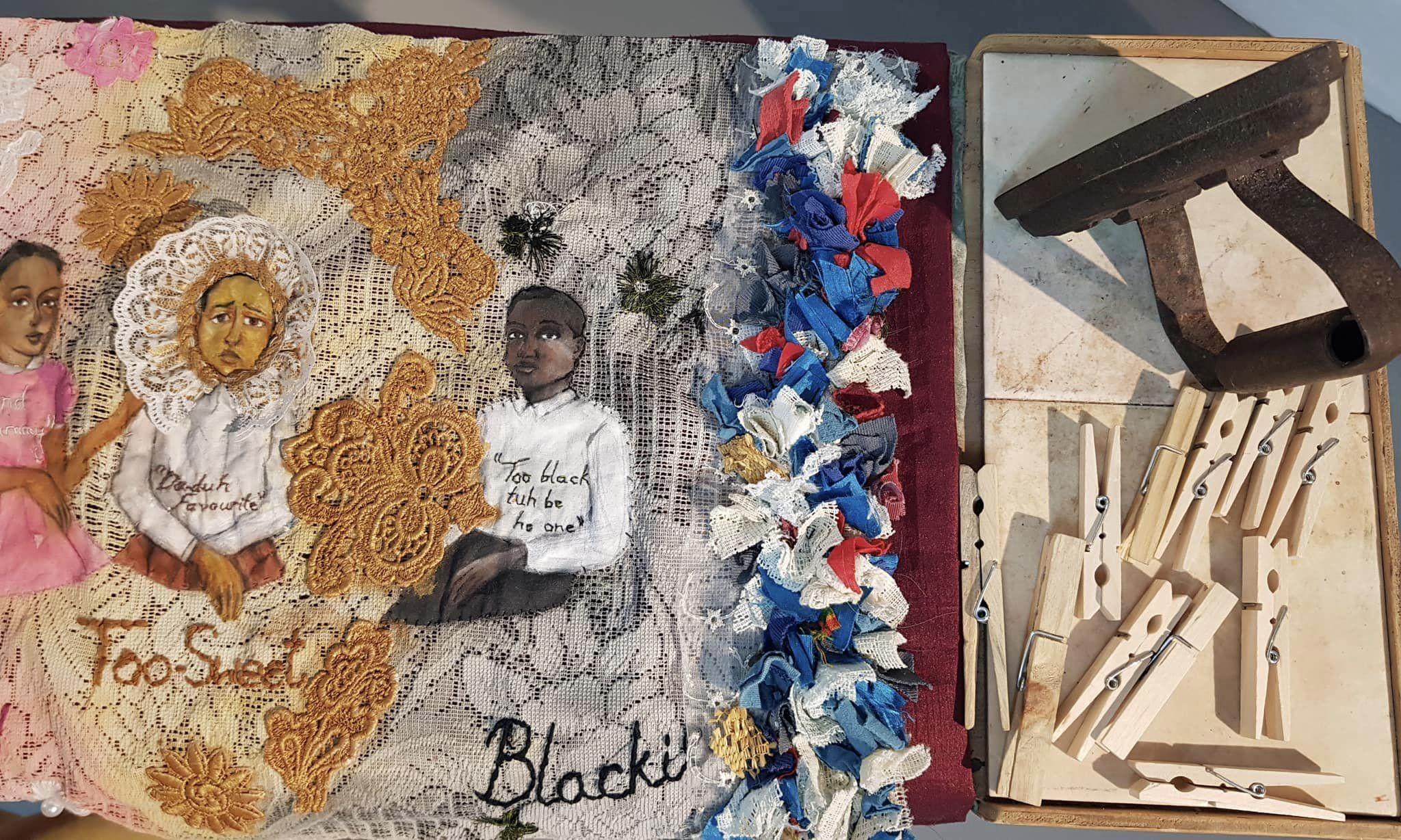



















Ja-hir Haynes
My work is based on the psychology behind perception and the important roles that history and knowledge, of an individual, play in the way they perceive and understand the information in their surroundings. Working primarily with the camera, I am interested in the use of various elements to convey feelings or thoughts of fear, with a particular focus on light and effect to create mysterious and alluring images.
The work is divided into two main areas of study: the first is inspired by horror tropes and liminal spaces to create uncomfortable feelings of haunting and the uncanny. The second area focuses on the body as a tool for communication. It highlights key parts such as fingers and eyes together with the use of filters and props to covey the feelings and state of mind of the subjects. The aim is to create images for the viewer to examine and recognize the familiar within the abstract, shrouded and mysterious.


Kiera Beckles
My work is a series of colourful works utilizing both geometric and organic shapes along with various collage elements; my art explores elements of my day-to-day life.
I look at everyday routines that might usually be taken for granted or unnoticed to find visual references. This series of work was inspired by the clothing my mother wears to work.
I documented my mother’s choice clothing each day, the patterns colours and textures.
I abstract them to create new patterns and meticulous compositions. In doing this I suggest that what might be tiresome routine can still hold inspiration for creativity. I want to encourage people to take a moment and observe the small elements you may overlook every day.
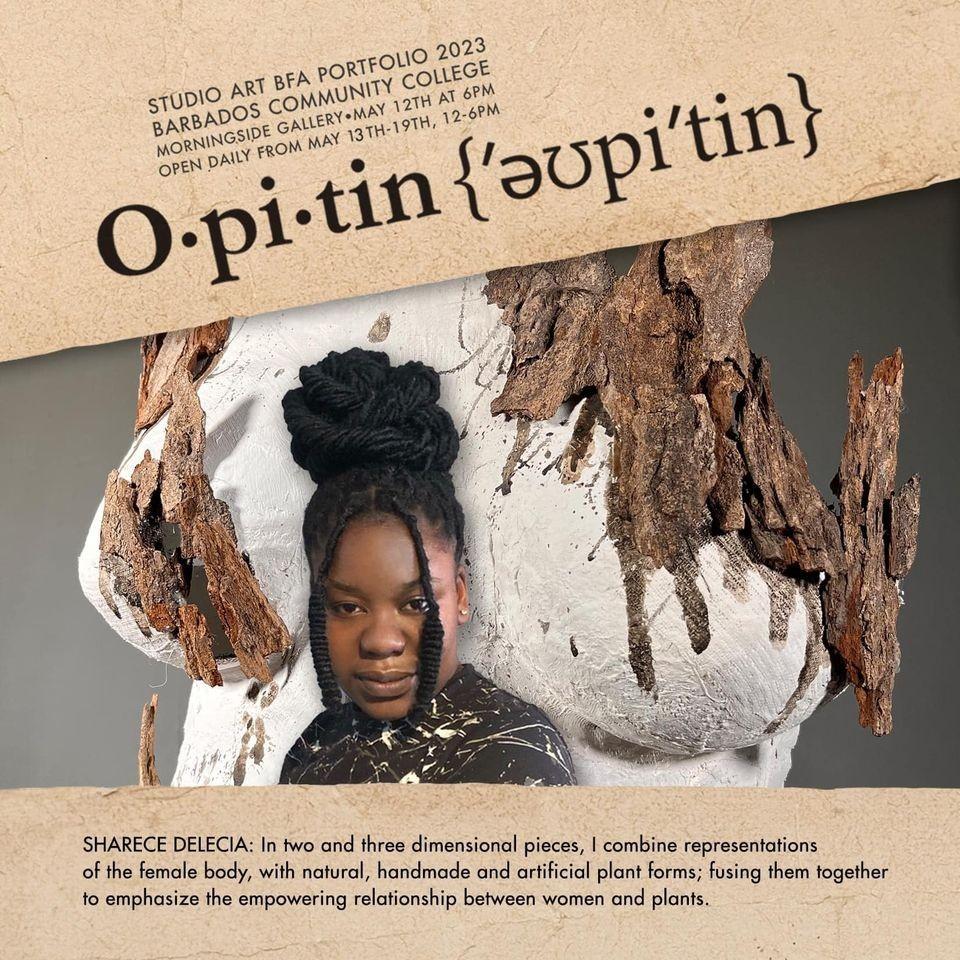

Sharece Delecia
My work explores traditional, plant- based remedies, particularly those that gave enslaved women the power to have greater control over their lifes and their bodies in patriarchal societies. My personal experiences with nature and it’s impact on my well being also inspires the work. Specific plants were injested and applied to the body for various effects like healing, abortion, suicide and poisoning.
In two and three dimensional pieces, I combine representations of the female body, with natural, handmade and artificial plant forms; fusing them together to emphasize the empowering relationship between women and plants. Using paints made from plants to create background pigments, became a way to incorporate these medicinal practices into my process.


Ariel Waithe
I’m interested in the construction of feminine identity and the celebration of the black female form. I want to reject the patriarchal idea that the pleasure of the black female form is reserved for a man as well as break the long tradition of the nude female body being represented male artists.
I explore my own identity and womanhood drawing on my own experiences of society. I look at different aspects of identity like sexuality, race, appearance etc and make work based off those themes.
I aim to depict different aspects of identity by deconstructing and reconstructing images using collage techniques, challenging conventional representation of the feminine. The spaces occupied by these bodies are imaginative spaces infused with fragments of domestic Caribbean homes along with flora and fauna inspired by Caribbean islands.


Tashawn Clarke
My work lies at the intersection of distortion and expression; I am interested in the dissection of an object or idea, in an attempt to give it new meaning, perspective, and even new representations. By doing so I investigate the relationship between parent, child, and things. In this installation, I guide the viewer through a space filled with recognizable and familiar objects.
All West Indian front rooms share many things in common, traditionally and visually. I have used materials and objects from the front room to create a new space in a way my child-like mind would, whether that be breaking ornaments or changing the position and character of the object while exploring themes like race, class, and identity. The West Indian front room was used to entertain guests and show off the many "things" in it. For my grandfather, it was a status symbol, a space where he showed off the best that he had. For me, it was a rigid and controlled environment. This experience of reconfiguring the front room allows me to analyze the behaviors and power dynamics in and out of that space. By rearranging objects and cultural symbols, I hope to alter traditional representations, encouraging viewers to reconsider social and historical narratives.
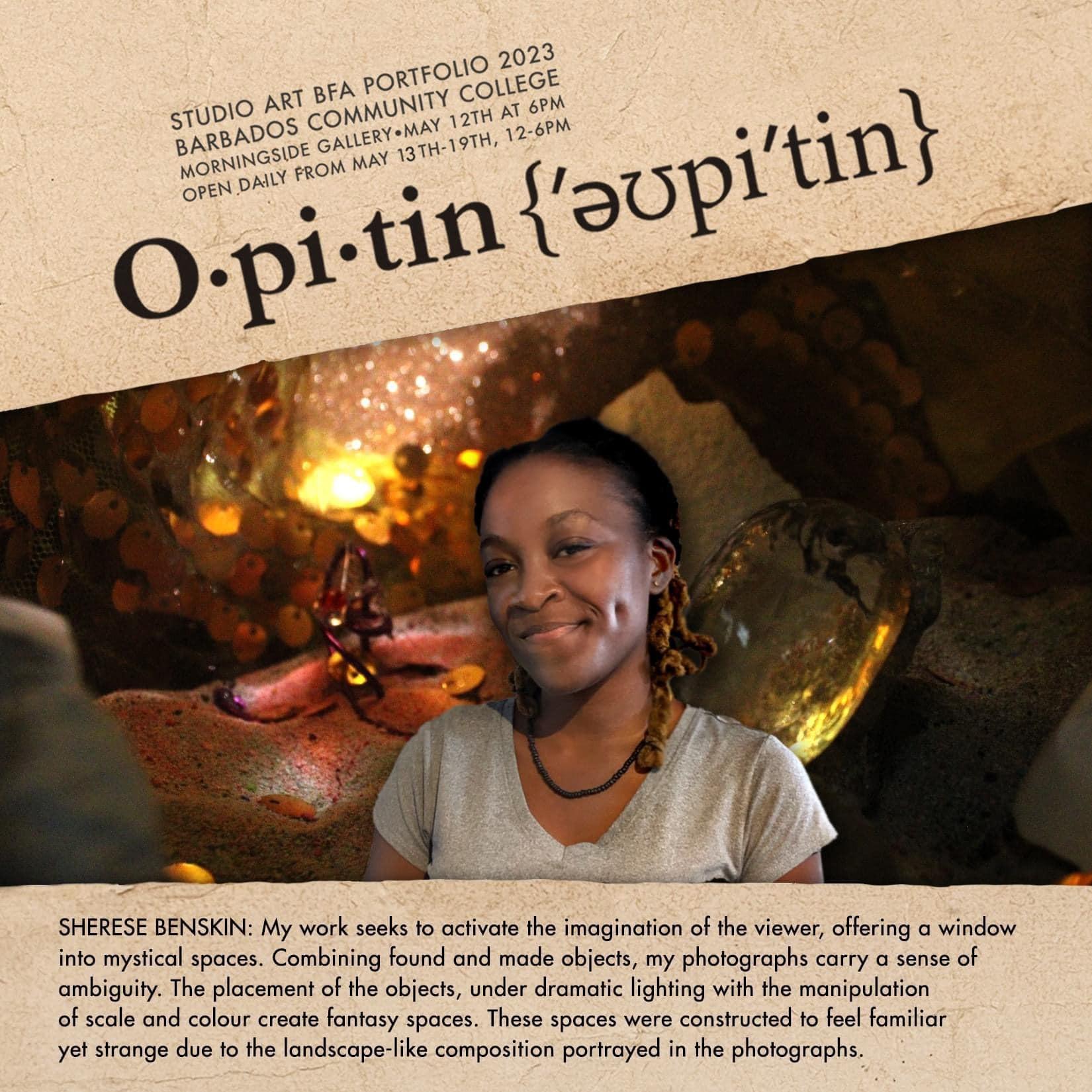

Sherese Benskin
My work seeks to activate the imagination of its viewers, offering a window into mystical spaces. This body of work carries the concept of creating environmental spaces using both found and created objects. My exploration first began after making miniature abstract sculptures and taking photos of these same objects using artificial light and various textured materials, to transform the original objects.
By combining found and made objects, these photographs carry a sense of ambiguity to them. The placement of the objects, under dramatic lighting with the manipulation of scale and colour create fantasy spaces. These spaces were constructed to feel familiar yet strange due to the landscape like composition portrayed in the photographs. This body of work is broken down into two themes, Mystical scapes and grief spaces. “Mystical scapes” is a reimaged version of St. Andrew portrayed as an otherworldly environment. The second project conceptually exhibit my interpretation of grief as a space amidst me processing my own.
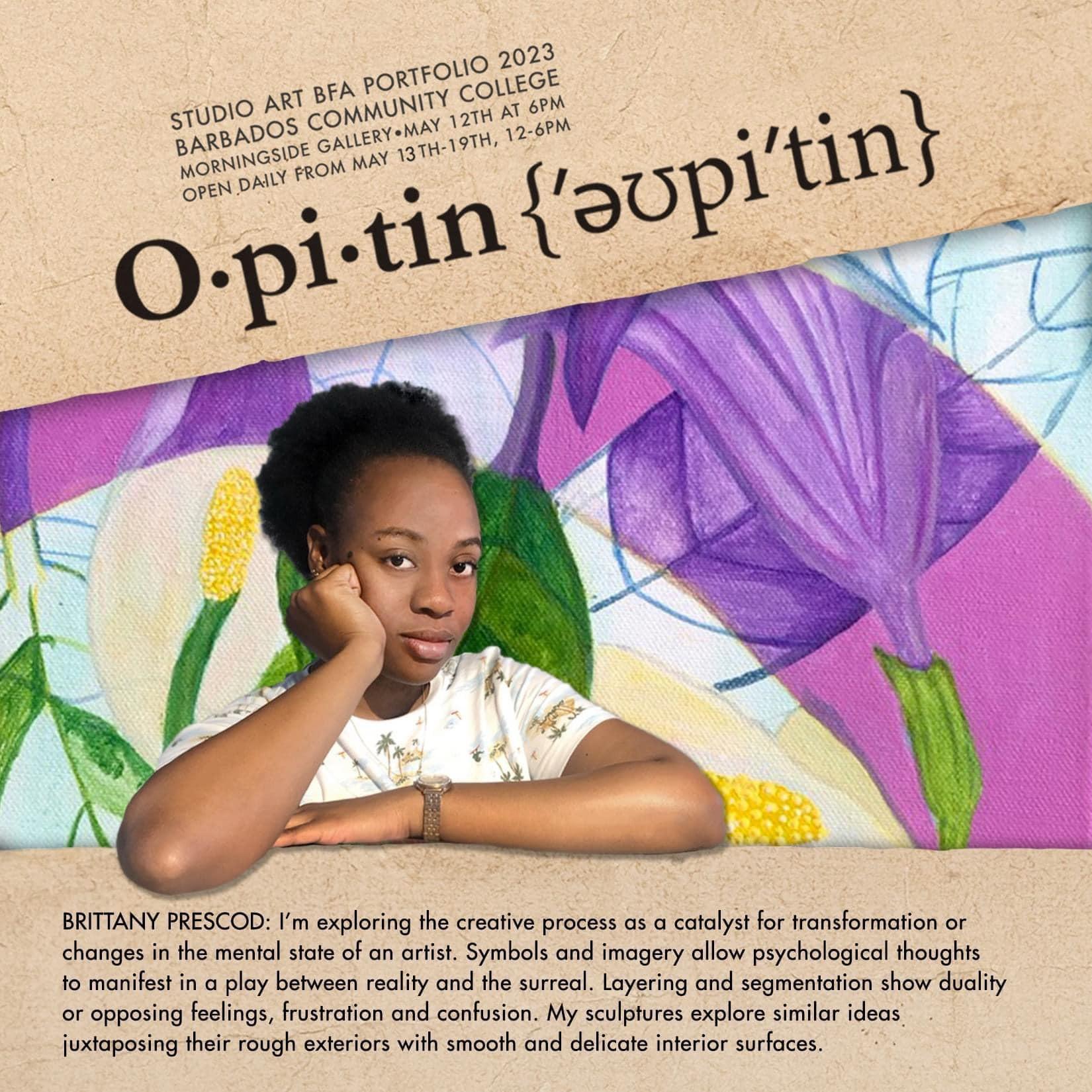

Brittany Prescod
I’m exploring the creative process as a catalyst for transformation or changes in the mental state of an artist. This first started as a visual journal, where I made use of layering and segmentation to show duality or opposing feelings, frustration and confusion which stemmed from a place of uncertainty and the development which came from acclimating to changing situations. Utilizing generated symbols and imagery inspired by psychedelia allowed my psychological thoughts to manifest in this play of reality and surrealism.
I’m also investigating the concept of fragility through brightly coloured sculpted vessels constructed of plaster. These sculptures question this with juxtaposing characteristics of oneself by portraying a very rough and jagged exterior and a smooth and delicate interior. I see water as a challenging environment and it permeates the vessel, demonstrating the sculptures' uniqueness while allowing them to exist in the same state simultaneously, and this is also demonstrated in video format.


